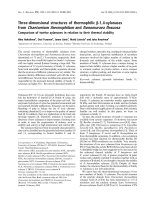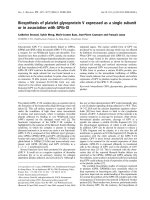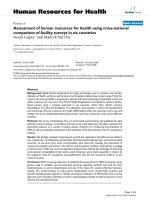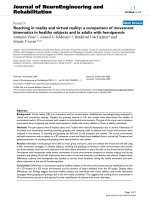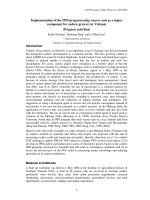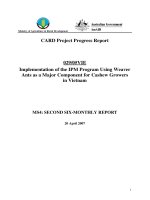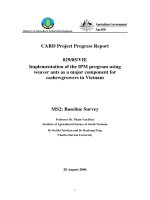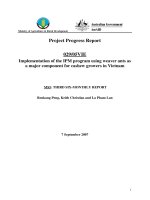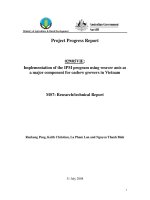Comparison of the obstetric anesthesia activity index with total delivery numbers as a single denominator of workload demand in Israeli maternity units doc
Bạn đang xem bản rút gọn của tài liệu. Xem và tải ngay bản đầy đủ của tài liệu tại đây (1.14 MB, 14 trang )
This Provisional PDF corresponds to the article as it appeared upon acceptance. Fully formatted
PDF and full text (HTML) versions will be made available soon.
Comparison of the obstetric anesthesia activity index with total delivery
numbers as a single denominator of workload demand in Israeli maternity units
Israel Journal of Health Policy Research 2012, 1:48 doi:10.1186/2045-4015-1-48
Yehuda Ginosar ()
Alex Ioscovich ()
Charles Weissman ()
Ronit Calderon-Margalit ()
Carolyn F Weiniger ()
ISSN 2045-4015
Article type Original research article
Submission date 23 May 2012
Acceptance date 23 August 2012
Publication date 14 December 2012
Article URL />This peer-reviewed article can be downloaded, printed and distributed freely for any purposes (see
copyright notice below).
Articles in Israel Journal of Health Policy Research are listed in PubMed and archived at PubMed
Central.
For information about publishing your research in Israel Journal of Health Policy Research or any
BioMed Central journal, go to
/>For information about other BioMed Central publications go to
/>Israel Journal of Health Policy
Research
© 2012 Ginosar et al.
This is an open access article distributed under the terms of the Creative Commons Attribution License ( />which permits unrestricted use, distribution, and reproduction in any medium, provided the original work is properly cited.
Comparison of the obstetric anesthesia activity index
with total delivery numbers as a single denominator
of workload demand in Israeli maternity units
Yehuda Ginosar
1*,†
*
Corresponding author
Email:
Alex Ioscovich
2,†
Email:
Charles Weissman
3
Email:
Ronit Calderon-Margalit
4
Email:
Carolyn F Weiniger
5
Email:
1
Department of Anesthesiology and Critical Care Medicine, Hebrew University,
Hadassah School of Medicine, Jerusalem, Israel
2
Department of Anesthesiology, Shaare Zedek Medical Center, Jerusalem, Israel
3
Department of Anesthesiology and Critical Care Medicine, Hebrew University,
Hadassah School of Medicine, Jerusalem, Israel
4
Hebrew University, Hadassah School of Public Health, Jerusalem, Israel
5
Department of Anesthesiology and Critical Care Medicine, Hadassah Hebrew
University Medical Center, Jerusalem, Israel
†
Equal contributors.
Abstract
Background
Obstetric anesthesia workload demand in Israel has increased due to both an increase in the
requests for labor analgesia and a marked increase in the cesarean delivery rate. We propose a
new workload-driven performance indicator, the Obstetric Anesthesia Activity Index
(OAAI), to serve as a single denominator of obstetric anesthesia activity to enable direct
comparison of different hospitals despite dissimilar rates of epidural labor analgesia and
cesarean delivery.
Methods
We performed a secondary analysis of two recent national surveys by the Israel Association
of Obstetric Anesthesia. In 2005 and 2007 questionnaires were sent to all Israeli hospitals
requesting information on the total numbers of deliveries, epidurals, and cesareans annually,
together with the anesthesia workforce allocated for the provision of obstetric anesthesia
services. The OAAI was calculated based on the premise that epidurals and cesareans are the
predominant determinants of obstetric anesthesia workload and that a typical epidural takes
about half the time of a typical cesarean. Accordingly, the OAAI for each hospital was
calculated as ((0.75 * number of epidurals per year) + (1.5 * number of cesareans per
year))/365.
Results
This secondary analysis assessed the 25 maternity units in Israel that participated in both the
2005 and 2007 surveys. As expected, there was a wide inter-hospital variability in epidural
and cesarean rates. Hospital rankings based on annual delivery numbers were different from
those based on the OAAI. The OAAI correlated closely both with the number of epidurals
(2005: Pearson 0.97, p < 0.0001; 2007: Pearson 0.97, p < 0.0001) and cesareans (2005:
Pearson 0.94, p < 0.0001; 2007: Pearson 0.92, p < 0.0001). These correlations were better for
the OAAI than for the annual delivery numbers.
Conclusions
As there was such a wide range of demand for different obstetric anesthesia services among
different hospitals, the total number of deliveries is a poor summary indicator of obstetric
anesthesia workload. The calculated OAAI better reflected the obstetric anesthesia workload
as a single denominator of activity.
Keyword
Activity, Delivery, Workload
Background
Israel is currently experiencing an anesthesia workforce crisis [1]. The imbalance between
anesthesia service demand and supply results from both reduced workforce supply (due to
poor recruitment of medical graduates to the specialty and dwindling immigration) and an
increase in overall workload demand (particularly in obstetric anesthesia) [1]. Obstetric
anesthesia workload in Israel has increased due to both an increase in the cesarean delivery
rate (rising from 9.6% in 1992 [2] to 17–18% by 2004 [3]) and epidural labor analgesia.
Laboring women may be disproportionately affected by the anesthesia workforce crisis, as
labor analgesia may be perceived to be neither life-saving nor profitable [4].
Recently we published a nationwide survey of all obstetric anesthesia unit directors in Israel
[4] to assess workload demand and workforce supply in obstetric anesthesia. The number of
deliveries per hospital per year is the traditional benchmark for maternity services activity,
but this was not the only factor found to determine demands for obstetric anesthesia
workload. Our data revealed a remarkably wide variation in the rates of epidural labor
analgesia and cesarean delivery among individual hospitals, suggesting that assessment of
obstetric anesthesia workforce should not be based purely on the annual number of deliveries.
We aim to present a new tool for determining the demand for obstetric anesthesia personnel.
For this purpose, we developed a single composite denominator of obstetric anesthesia
activity, the Obstetric Anesthesia Activity Index (OAAI), and performed a secondary analysis
of data from our previous study [4] in order to assess its usefulness. We hypothesized that the
OAAI would enable direct comparison of obstetric anesthesia workload demands of different
hospitals despite dissimilar epidural and cesarean rates. Studies of obstetric anesthesia
workload typically report annual delivery numbers. To our knowledge, this is the first report
of a workload-directed performance indicator of obstetric anesthesia services. The derivation
and limitations of this novel index are described.
Methods
The Israel Association of Obstetric Anesthesia regularly uses surveys as part of an ongoing
assessment of national obstetric anesthesia clinical activity. The methodology of these
surveys has been previously described [4]. Briefly, a questionnaire was sent on two occasions
to all directors of departments of anesthesia or the nominated directors of the obstetric
anesthesia units or services in all Israeli hospitals providing labor and delivery services. The
questionnaires contained groups of questions relating to the annual number of deliveries,
epidural rates, cesarean rates, and the anesthesia staffing for provision of obstetric anesthesia
services (day and night). Other questions included the estimated waiting time for epidural
labor analgesia and the anesthesia choices for cesarean delivery. A detailed survey (including
anesthesia workforce) was performed in 2005; questions regarding annual number of
deliveries, epidural rates, and cesarean rates were repeated in the 2007 survey. Questionnaires
were mailed at the end of December with a follow-up telephone reminder after one month
and again after an additional month if required. The survey requested data relating to
obstetric anesthesia services provided between January and December of the completed year.
Twenty-five hospitals were surveyed in 2005. In 2007 there were an additional 2 hospitals
providing independent obstetric anesthesia services [4]. In the current secondary analysis
only data from the 25 hospitals participating in both surveys are presented. There was a 100%
response rate from both surveys.
Units were categorized according to whether there was an anesthesiologist dedicated to the
labor ward: (1) 24 h per day, seven days per week; (2) day shifts only (on weekdays); or (3)
no shifts either day or night. Hospitals were also categorized based on the predominant ethnic
or religious demography of the population using their local facilities: (1) a predominantly
ultra-Orthodox Jewish population, (2) a predominantly Bedouin or Arab population, or (3) a
heterogeneous population.
As the rates of epidural labor analgesia and cesarean delivery varied widely between the
different hospitals for both surveys [4], we sought to develop a single denominator of
obstetric anesthesia activity to offset this heterogeneity.
The obstetric anesthesia activity index (OAAI)
The majority of anesthesia workload in the labor ward comprises epidural labor analgesia and
cesarean delivery. The OAAI is a formula composite comprising data taken from the annual
numbers of epidurals and cesareans in each institution. In this study, these data were self-
reported by the local unit director for each individual institution and were not corroborated by
independent observers. Calculation of the OAAI was based on clinical experience that a
typical epidural will take approximately half the time of a typical cesarean [5].
Consequently, the OAAI was calculated using the following formula:
(
)
(
)
OAAI = no. of epidurals per yr*0.75 no. of
cesareans per yr*1.5 / 365
+
(1)
The ratio of the epidural and cesarean components of the OAAI (OAAI
EPI
and OAAI
CD
) was
also calculated as follows:
(
)
(
)
CD/EPI
OAAI = no. of cesareans per yr*1.5 / no. of
epidurals per yr*0.75
(2)
Statistical methods
Quantitative variables are presented as mean ± standard deviation and were compared
between groups using the independent samples t-test. Categorical data are presented as
percentages and were compared between the study groups using the chi-square test or Fisher's
exact test. The correlation between two variables was compared using Pearson's correlation
coefficient where appropriate (variables are continuous and normally distributed; the two
variables were independent and the relationship between them was linear). All statistical tests
were two sided and a p-value < 0.05 was considered statistically significant. Statistical
analysis was performed using SPSS 17.0 (SPSS Inc. Chicago, Illinois).
Results
There was a wide inter-hospital variability in the epidural and cesarean rates in both periods
surveyed (Table 1). The annual delivery numbers do not reliably reflect these key
components of obstetric anesthesia workload. Hospital rankings based on annual delivery
numbers were significantly different from rankings based on the OAAI (Figure 1). There was
a wide inter-hospital variation for the OAAI
CD/EPI
because of a wide variation in epidural and
cesarean components of OAAI (Figure 2). In 2005, median OAAI
CD/EPI
was 0.88; range 0.45
(60% epidural, 12% cesarean) to 9.5 (4% epidural, 16% cesarean). In 2007, median OAAI
CD/EPI
was 1.0; range from 0.35 (50% epidural, 8% cesarean) to 5.0 (10% epidural, 20%
cesarean).
Table 1 Raw data from national surveys of obstetric anesthesia units in Israel, showing the
annual delivery numbers and the epidural and cesarean delivery rates (%) with the calculated
OAAI
2005
2007
Deliveries
(no./year)
Epidural
rate (%)
Cesarean
rate (%)
OAAI
Deliveries
(no./year)
Epidural
rate (%)
Cesarean
rate (%)
OAAI
12,000 20 18 12.92
12,000 27 19 14.93
9,500 93 27 23.79
10,000 85 26 23.61
9,000 60 12 14.20
11,000 50 8 14.01
9,000 90 25 21.73
10,000 90 25 24.14
8,600 55 23 15.61
8,000 55 23 14.52
6,000 24 17 6.65 6,000 40 18 8.44
6,000 45 10 7.46 7,300 45 27 13.03
5,500 70 25 11.58
5,500 70 25 11.58
5,500 54 19 9.16 5,782 54 15 9.02
5,300 63 20 9.84 5,600 56 18 9.43
5,000 65 20 9.45 5,000 70 18 9.60
4,500 35 22 6.59 4,500 60 23 8.53
4,500 60 18 7.88 5,440 53 18 8.87
4,500 22 18 4.91 4,200 20 19 4.68
4,500 40 22 6.95 4,000 45 23 6.60
4,000 35 17 5.18 3,900 27 28 6.05
3,700 40 10 4.26 4,398 38 10 4.96
3.200 60 18 5.60 3,188 67 20 6.10
2,700 22 22 3.39 2,788 26 18 3.28
2,690 20 20 3.10 2,969 20 22 3.56
2,600 4 16 1.89 2,000 15 18 1.98
2,500 68 20 4.85 3,500 74 24 7.50
2,350 50 18 3.72 2,548 49 23 4.36
1,300 10 20 1.28 2,000 10 20 1.97
900 70 23 1.85 1,000 75 24 2.16
Figure 1 The wide variation in epidural and cesarean delivery rates in Israeli hospitals
makes annual delivery numbers a poor assessment of obstetric anesthesia activity. For
each composite figure, the upper portion consists of annual numbers of deliveries, epidurals,
and cesareans. The lower portion represents the calculated OAAI. Ranking of hospital
activity by annual delivery numbers alone does not reflect the ranking by OAAI. Data for
2005 (upper) and 2007 (lower)
Figure 2 The wide variation in epidural and cesarean delivery rates in Israeli hospitals
is reflected in the contributions of epidural analgesia and cesarean anesthesia to the
total OAAI in individual hospitals. Data for 2005 (left) and 2007 (right)
The OAAI correlated with epidural rates and cesarean rates more closely than did the annual
number of deliveries (Figure 3). There was no clear relationship between the anesthesia
workforce allocation to the labor ward and the obstetric anesthesia workload as measured by
the OAAI (Figure 4).
Figure 3 Correlation of annual epidural and cesarean numbers with annual delivery
numbers (A, C) and with OAAI (B, D). Data for 2005 (A, B) and 2007 (C, D). The OAAI
correlated more closely with both the number of cesarean deliveries and the number of
epidurals. Although coupling exists as the OAAI is derived from both cesarean delivery and
epidural rates, it is precisely for this reason that a single denominator is a more useful
measure of obstetric anesthesia activity than annual delivery numbers
Figure 4 The OAAI for individual hospitals according to obstetric anesthesia workforce
allocation (data for 2005 only; 2007 survey did not collect workforce data)
Discussion and conclusion
This study reports data derived from a self-reported questionnaire from obstetric anesthesia
unit directors. The study found that total number of deliveries was a poor measure of obstetric
anesthesia workload. The OAAI is a workload-directed performance indicator and better
reflects the obstetric anesthesia workload than merely measuring the total number of
deliveries. Use of the annual number of deliveries as the bench-mark comparator for
maternity services will under-estimate obstetric anesthesia activity in centers with high
epidural rates and will over-estimate it in centers with low epidural rates. Consequently, the
OAAI may be useful as a denominator in obstetric anesthesia workforce staffing calculations.
There was a wide range of demand for different obstetric anesthesia services among the
different hospitals. However, there was no clear relationship between the allocation of
obstetric anesthesia workforce to labor wards in Israel and the obstetric anesthesia workload
as measured by the OAAI.
Ensuring adequate staffing levels for obstetric anesthesia units is important for both patient
satisfaction and patient safety. From our previously published data, hospitals with a dedicated
anesthesiologist in the labor ward 24 h per day/7 days per week had a two-fold increase in the
epidural rate and half the epidural waiting time, when compared to hospitals where the
anesthesiologist had to be called from the operating room [4]. In addition to the provision of
analgesia, a functioning epidural catheter can be used for the provision of epidural surgical
anesthesia for urgent cesarean delivery without the need for potentially hazardous emergency
general anesthesia. Maternal death due to anesthesia is the sixth leading cause of pregnancy-
related death in the United States [6] and most anesthesia-related deaths occur during general
anesthesia for urgent cesarean delivery. The risk of maternal death from complications of
general anesthesia is 17 times that associated with regional anesthesia [7]. Therefore, the
finding in our earlier study that there was an inverse relationship between the epidural rate for
labor analgesia and the choice of general anesthesia for emergency cesarean delivery [4]
suggests that inadequate obstetric anesthesia workforce supply may have adverse effects on
patient safety. Other studies have reported the adequacy or inadequacy of obstetric anesthesia
workforce in relation to total delivery numbers [8]. The current study is the first stage in an
approach that will attempt to define the adequacy of obstetric anesthesia workforce in relation
to activity.
The epidural component of the OAAI includes time taken for pre-analgesia assessment,
sterile preparation, block placement, incremental drug dosing (over several minutes), and at
least 15-20 min bedside observation following completion of drug administration. A labor
epidural should never take less than 30 min, and typically takes in the region of 45 min. The
time spent on anesthesia for cesarean delivery is rarely less than 90 min although surgical
time varies between hospitals, surgeons, and patient risk-factors, and time spent waiting for
post-anesthesia care unit.
Like any composite measure, the OAAI does not specifically identify the individual
predominant contributing component. The OAAI ignores requests to provide supplementary
epidural analgesia throughout labor [9], although this element can be greatly reduced by the
use of patient-controlled analgesia pumps. The OAAI ignores clinical activities other than
epidural analgesia and cesarean anesthesia (including anesthesia for retained placenta and
complicated vaginal deliveries, antenatal or pre-operative consultation, and resident training).
In some centers, the obstetric anesthesia team also provides anesthesia services for non-
obstetric gynecological operations and for post-anesthesia care units. The OAAI cannot
account for lengthy epidural analgesia and cesarean deliveries or differentiate between
day/night/weekend shifts and experience of personnel. Accordingly, the OAAI is not a
measure of the total activity of the obstetric anesthesia services.
Based on these limitations, it is important to appreciate that although the OAAI is
numerically identical to the time (in hours) spent engaged in epidurals and cesareans in an
average 24 h period, the OAAI is a dimensionless index of activity and is not a measurement
of time.
Additionally, the OAAI does not consider the degree of workforce redundancy that is
required to safely accommodate extra workload during peak activity or provide expert back-
up when the maternity services are located in remote locations away from the main anesthesia
services. Provision of back-up is particularly important when considering emergency
cesareans and the data could not differentiate between elective and emergency cesarean
delivery. Finally, while it is obvious that coupling exists, as the OAAI is derived from both
epidural rates and cesarean rates, it is precisely for this reason that this single denominator is
a more reliable measure of activity than annual delivery numbers.
A limitation of the data upon which this secondary analysis is based is that data were self-
reported and not corroborated; in almost all cases data were approximated by the unit
directors. Part of the explanation for this finding is that many hospitals have no computerized
data management system. A national observational study is underway in Israel to assess the
obstetric anesthesia workforce supply and work load demand ratio, based on the OAAI, and
to correlate this with quantifiable measures of adequacy of obstetric anesthesia services. That
study may provide corroboration for the data presented in this study and will attempt to
identify an ideal obstetric anesthesia staffing number based on the OAAI.
In summary, the use of the OAAI may facilitate a comparison of the workforce supply –
workload demand ratio (and defined obstetric outcomes) for hospitals with different
geographical (center versus periphery) and cultural (ultra-Orthodox Jews, Arabs and
Bedouins, versus heterogeneous) demographic populations. Such studies may provide the
data to support a change in health care resource allocation, to provide obstetric anesthesia
workforce commensurate with obstetric anesthesia workload demands [10], and to provide
uniform levels of care throughout the country. Based on these studies, it is possible that
future recommendations for obstetric anesthesia staffing ratios will need to use the OAAI, or
a similar index, as a single workload denominator.
Competing interests
There are no competing interests declared for any author.
Author information
Yehuda Ginosar is Senior Lecturer of Anesthesia and Director of the Mother and Child
Anesthesia Unit at the Hadassah–Hebrew University Medical Center. He is a past Chair of
the Israel Association of Obstetric Anesthesia. His main research interests are focused on
anesthetic interventions to improve fetal well-being in high risk pregnancy and spinal cord
anesthetic pharmacology.
Alex Ioscovich is Clinical Senior Lecturer of Anesthesia and Director of the Obstetric
Anesthesia Unit at Shaarei Zedek Medical Center. He is the current Chair of the Israel
Association of Obstetric Anesthesia. His main clinical research interests are focused on
clinical obstetric anesthesia and grandmultiparity.
Charles Weissman is Professor of Anesthesia and Director of the Department of
Anesthesiology and Critical Care, at the Hadassah–Hebrew University Medical Center. His
main research interests are focused on critical care, nutrition, surgical stress response, and the
organization of anesthesia services.
Ronit Calderon-Margalit is Senior Lecturer in Epidemiology at the Hebrew University–
Hadassah, Braun School of Public Health. Her main research interests are focused on
women's health and perinatal care.
Carolyn F. Weiniger is Senior Lecturer in Anesthesiology and lead clinician in the Antenatal
Anesthesia Consultation Service at the Hadassah–Hebrew University Medical Center. Her
main research interests are focused on major obstetric hemorrhage, the use of spinal
anesthesia for breech conversion, the use of an ultra-short-acting opioid analgesic drug as an
alternative to epidural for labor pain relief, and the development of long-acting local
anesthetic polymers.
Authors’ contributions
YG devised the obstetric anesthesia activity index; YG and CFW wrote the draft manuscript;
AI, CW and RCM all read the draft manuscript and all made important intellectual
contributions to the final version.
Acknowledgments
Dr Shimon Ivri, Director, Department of Anesthesiology, Western Galilee Hospital,
Nahariyah, Israel, initiated the Israel Obstetric Anesthesia Surveys and supervised data
collection for the 2005 survey data. Professor Shmuel Evron, Director, Obstetric Anesthesia
Unit, Wolfson Medical Center, Holon, Israel, assisted with data collation for the 2007 survey
data.
References
1. Weissman C, Eidelman LA, Pizov R, Matot I, Klein N, Cohn R: The Israeli
anesthesiology physician workforce. Isr Med Assoc J 2006, 8:255–60.
2. Mor-Yosef S, Samueloff A, Schenker JG: The Israel perinatal census. Asia Oceania J
Obstet Gynecol 1992, 18:130–45.
3. Cohain JS: Midwifery in Israel. Midwifery Today Int Midwife 2004, 71:50–1.
4. Weiniger CF, Ivri S, Ioscovitch A, Grimberg L, Evron S, Ginosar Y: Obstetric anesthesia
units in Israel: a national questionnaire-based survey. Int J Obstet Anesth 2010, 19:410–6.
5. Bell ED, Penning DH, Cousineau EF, White WD, Hartle AJ, Gilbert WC, Lubarsky DA:
How much labor is in a labor epidural? manpower cost and reimbursement for an
obstetric analgesia service in a teaching institution. Anesthesiology 2000, 92:851–8.
6. Berg CJ, Atrash HK, Koonin LM, Tucker M: Pregnancy-related mortality in the United
States, 1987–1990. Obstet Gynecol 1996, 88:161–7.
7. Hawkins JL, Koonin LM, Palmer SK, Gibbs CP: Anesthesia-related deaths during
obstetric delivery in the United States, 1979–1990. Anesthesiology 1997, 86:277–84.
8. Bucklin BA, Hawkins JL, Anderson JR, Ullrich FA: Obstetric anesthesia workforce
survey: twenty-year update. Anesthesiology 2005, 103:645–53.
9. Thomson RG, Bryson M, Donaldson LJ: Obstetric anaesthesia: an approach to
improving the standards of services. Int J Obst Anesth 1997, 6:250–6.
10. Engen DA, Morewood GH, Ghazar NJ, Ashbury T, VanDenKerkhof EG, Wang L: A
demand-based assessment of the Canadian anesthesia workforce: 2002 through 2007.
Can J Anaesth 2005, 52:18–25.
Figure 1
Figure 2
Figure 3
Figure 4
